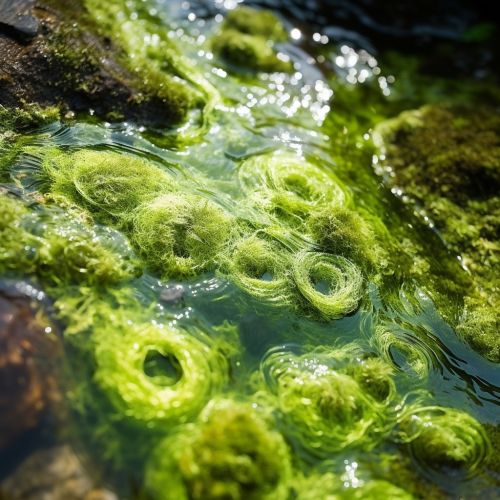Algae
Introduction
Algae are a diverse group of aquatic organisms that have the ability to conduct photosynthesis. Certain algae are familiar to most people; for instance, seaweeds (such as kelp or phytoplankton), pond scum or the algal blooms in lakes. Yet there are many different types of algae that play key roles in ecosystems, including serving as the base of the food web for all aquatic life. Algae can be found in a variety of environments, including fresh and marine waters, the surface of soil, on rocks, trees, and even snow.


Classification
Algae are classified into several different phyla, based on their pigmentation, the composition of their cell walls, the organization of their chloroplasts, the presence or absence of flagella, and the type of storage products they produce. The major groups of algae include the green algae, red algae, brown algae, diatoms, dinoflagellates, euglenoids, and blue-green algae (or cyanobacteria).
Green Algae
Green algae are a large group of algae that includes both unicellular and multicellular species. They are named for their vibrant green color, which comes from their high chlorophyll content. Green algae are found in a variety of habitats, including freshwater, marine environments, and on land.
Red Algae
Red algae, or Rhodophyta, are primarily marine algae that are known for their brilliant red color. They are an important part of coral reefs and other marine ecosystems.
Brown Algae
Brown algae are a large group of algae that includes the seaweeds. They are named for their characteristic brown color, which comes from their high content of the pigment fucoxanthin.
Diatoms
Diatoms are a major group of algae found in the oceans, waterways and soils of the world. They are unique among algae in that their cell walls are made of silica.
Dinoflagellates
Dinoflagellates are a group of flagellate algae that are known for their role in creating red tides. They are also important as symbionts of coral reefs.
Euglenoids
Euglenoids are a group of flagellate algae that are known for their ability to move toward light.
Blue-Green Algae
Blue-green algae, or cyanobacteria, are a type of bacteria that obtain their energy through photosynthesis. They are often considered as algae because they are aquatic and photosynthetic.
Reproduction
Algae reproduce in a variety of ways. They can reproduce asexually through simple cell division, fragmentation or the formation of spores. Some algae also reproduce sexually, through the fusion of gametes.
Ecological Role
Algae play a crucial role in aquatic ecosystems. They form the base of the food chain in these environments, providing food for a wide range of organisms. Algae also play a key role in the carbon cycle, as they absorb carbon dioxide during photosynthesis and produce oxygen.
Economic Importance
Algae have a variety of economic uses. They are harvested for their high nutrient content and are used in foods, fertilizers, and animal feed. Certain types of algae are also used in the production of biofuels, while others have potential in bioremediation, the use of organisms to clean up pollution.
